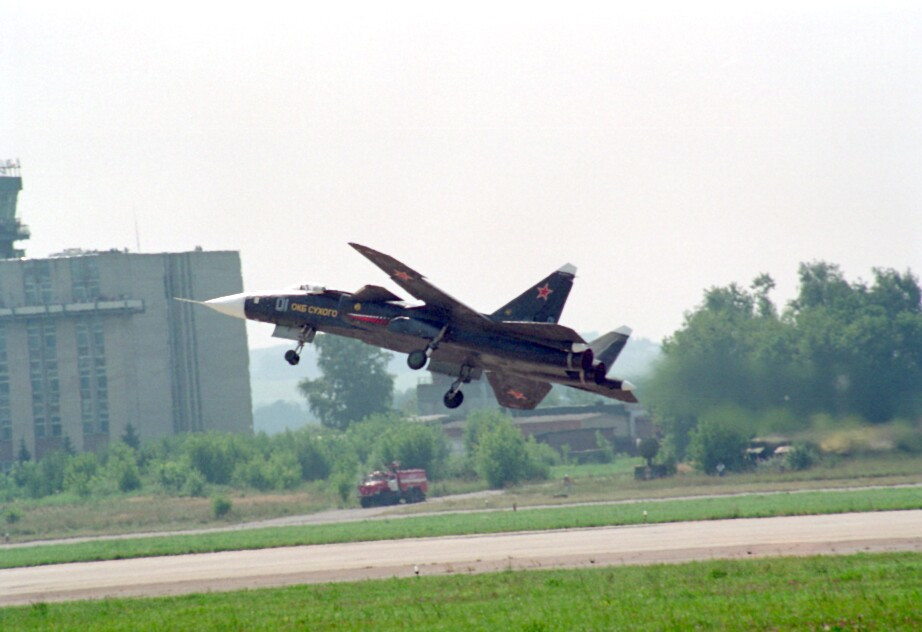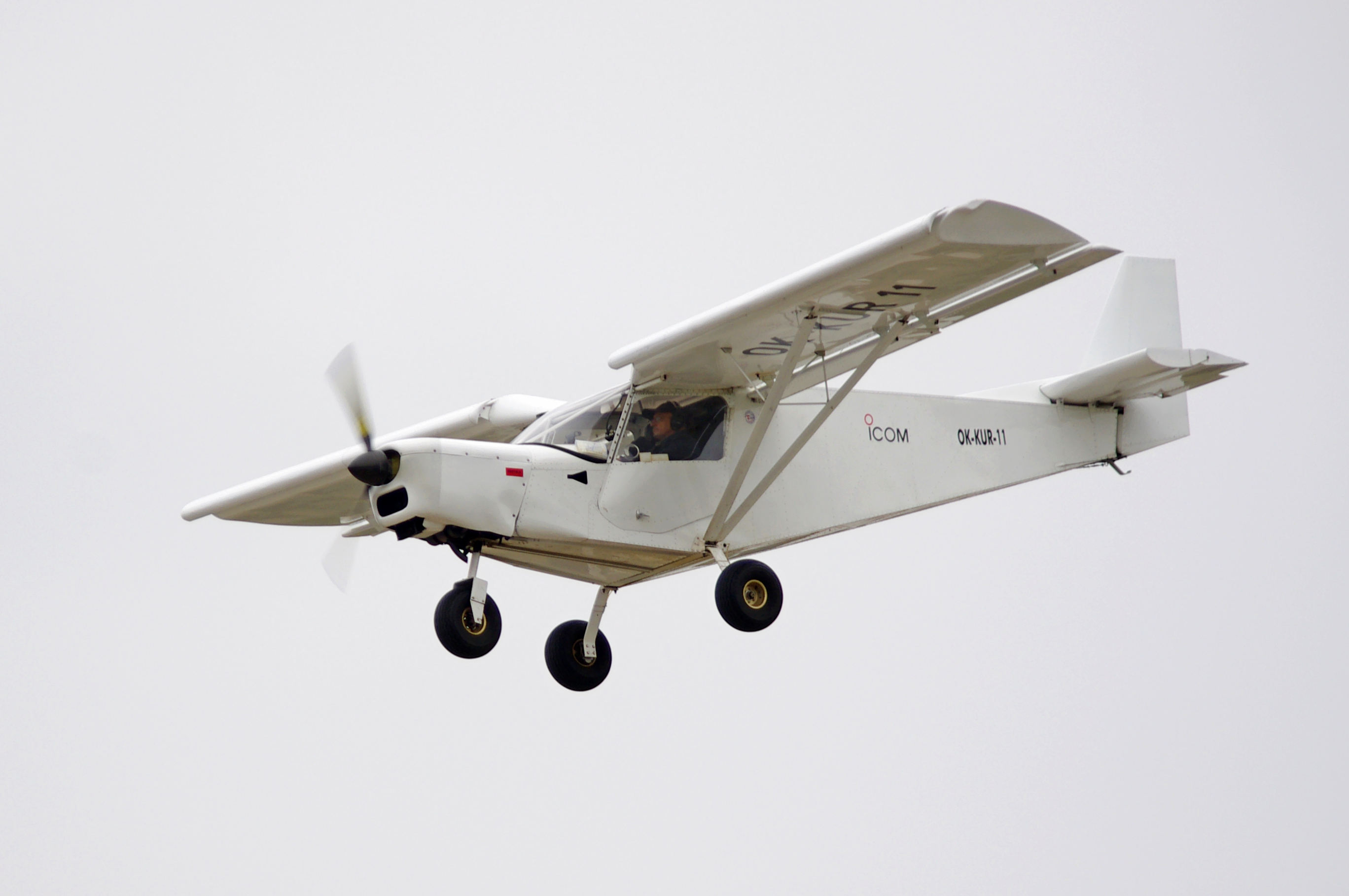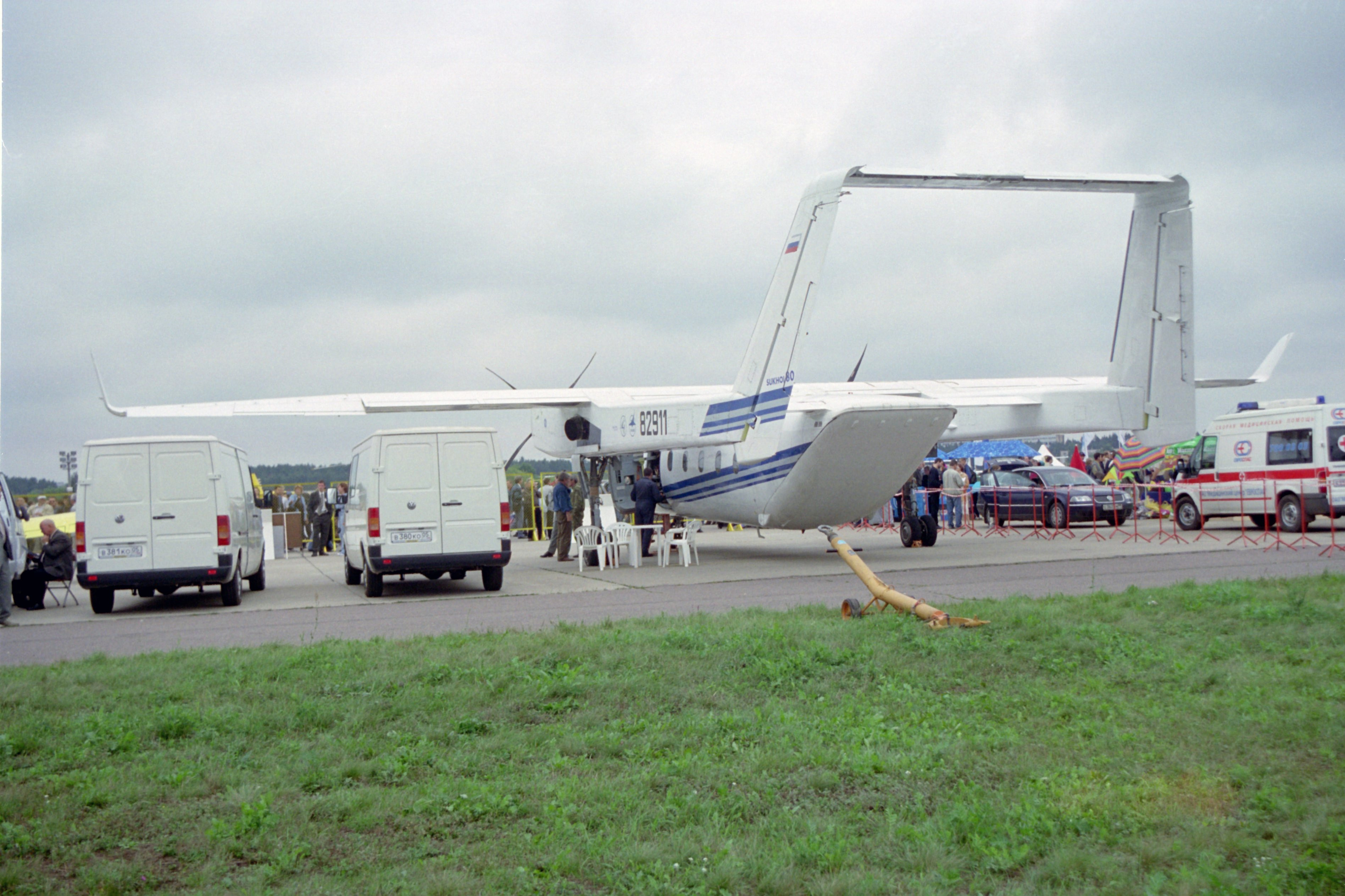|
List Of Sukhoi Aircraft
This is a list of aircraft produced by Sukhoi, a Russian aircraft manufacturer. Products Production Aircraft Military Aircraft Civilian Aircraft Experimental aircraft * Su-1/I-330: high-altitude fighter, 1940 * Su-3/I-360: improved Su-1, 1942 * Su-4/BB-3: prototype version of Su-2 re-engined with a M-90 engine, 1941 * Su-5/I-107: prototype motorjet fighter, 1945 * Su-6: ground attack aircraft, 1942 * Su-7: prototype mixed-power high-altitude interceptor, 1944 * Su-8/DDBSh: ground attack aircraft, 1943 *Su-9: jet fighter, 1946 *Su-10: four-engine jet bomber, 1946 * Su-11: prototype twin-engine fighter developed from the Su-9, resembled the Me 262, 1946 * Su-12: observation plane, 1947 * Su-13: prototype twin-engine jet fighter developed from the Su-11, 1947 *Su-15: fighter-interceptor, 1949 *Su-17: fighter, 1949 *Sukhoi-Gulfstream S-21: a supersonic business jet design. * Sukhoi KR-860: doubledeck superjumbo jet design. *Su-37 ("Terminator"): an improved Su-35 * Su-28 ... [...More Info...] [...Related Items...] OR: [Wikipedia] [Google] [Baidu] |
Sukhoi
The JSC Sukhoi Company (, ) is a Russian aircraft manufacturer headquartered in Begovoy District, Northern Administrative Okrug, Moscow, that designs both civilian and military aircraft. Sukhoi was founded in the Soviet Union by Pavel Sukhoi in 1939 as the Sukhoi Design Bureau (OKB-51, design office prefix Su), and survived the dissolution of the Soviet Union. In February 2006, the Russian government merged Sukhoi with Mikoyan, Ilyushin, Irkut, Tupolev, and Yakovlev as a new company named United Aircraft Corporation.Russian Aircraft Industry Seeks Revival Through Merger ." ''.'' February 22, ... [...More Info...] [...Related Items...] OR: [Wikipedia] [Google] [Baidu] |
Sukhoi Su-30
The Sukhoi Su-30 (; NATO reporting name: Flanker-C/G/H) is a twin-engine, two-seat supermaneuverable fighter aircraft developed in the Soviet Union in the 1980s by Russia's Sukhoi Aviation Corporation. It is a multirole fighter for all-weather, air-to-air interdiction missions. The Russian Aerospace Forces (VKS) were reported to have 130 Su-30SMs in operation as of 2024. The Su-30 started as an internal development project in the Sukhoi Su-27 family by Sukhoi. From the Su-27UB two-seat trainer, the Su-27PU heavy interceptor was developed. The design plan was revamped and the Su-27PU was renamed to Su-30 by the Russian Defense Ministry in 1996. Of the Flanker family, the Su-27, Su-30, Su-33, Su-34 and Su-35 have been ordered into limited or serial production by the Russian Defense Ministry. Later, different export requirements split the Su-30 into two distinct version branches, manufactured by competing organizations: KnAAPO and the Irkut Corporation, both of which come un ... [...More Info...] [...Related Items...] OR: [Wikipedia] [Google] [Baidu] |
Sukhoi Su-30MKM
The Sukhoi Su-30MKM (NATO reporting name: Flanker-H) is a twin-engine supermaneuverable fighter of the Royal Malaysian Air Force (RMAF). It is a variant of the Su-30 series fighters, with many significant improvements over the original Su-30MK export version. The Su-30MKM was developed by the Sukhoi Design Bureau and is based on the Su-30MKI of the Indian Air Force. Both aircraft have common airframe, thrust vectoring engines and a digital fly-by-wire system, however the MKM version differs from the MKI mainly in the composition of the onboard avionics. It can carry up to payload over a un-refueled combat radius. In 2003, the Su-30MKM was selected by the Royal Malaysian Air Force. In August 2003, during the course of President Vladimir Putin's official visit to Malaysia, the contract for the Su-30MKM aircraft was signed. Except for Russian MiG-29s, the RMAF has previously operated aircraft of Western origin. Development In August 2003, Malaysia signed a US$900 million contra ... [...More Info...] [...Related Items...] OR: [Wikipedia] [Google] [Baidu] |
Strike Fighter
In current military parlance, a strike fighter is a multirole combat aircraft designed to operate both as an attack aircraft and as an air superiority fighter. As a category, it is distinct from fighter-bombers, and is closely related to the concept of Interdictor, interdictor aircraft, although it puts more emphasis on aerial combat capabilities. Examples of notable contemporary strike fighters are the American McDonnell Douglas F-15E Strike Eagle, Boeing F/A-18E/F Super Hornet and Lockheed Martin F-35 Lightning II, Lockheed F-35 Lightning II, the Russian Sukhoi Su-34, and the Chinese Shenyang J-16. History Beginning in the 1940s, the term "strike fighter" was occasionally used in navies to refer to fighter aircraft capable of performing air strike, air-to-surface strikes, such as the Westland Wyvern, Blackburn Firebrand and Blackburn Firecrest. The term "light weight tactical strike fighter (LWTSF)" was used to describe the aircraft to meet the December 1953 NATO specificati ... [...More Info...] [...Related Items...] OR: [Wikipedia] [Google] [Baidu] |
Fighter-bomber
A fighter-bomber is a fighter aircraft that has been modified, or used primarily, as a light bomber or attack aircraft. It differs from bomber and attack aircraft primarily in its origins, as a fighter that has been adapted into other roles, whereas bombers and attack aircraft are developed specifically for bombing and attack roles. Although still used, the term fighter-bomber has less significance since the introduction of rockets and guided missiles into aerial warfare. Modern aircraft with similar duties are now typically called multirole combat aircraft or strike fighters. Development Prior to World War II, general limitations in available Aircraft engine, engine and Aerospace engineering, aeronautical technology required that each proposed military aircraft have its design tailored to a specific prescribed role. Reciprocating engine, Engine power grew dramatically during the early period of the war, roughly doubling between 1939 and 1943. The Bristol Blenheim, a typical ... [...More Info...] [...Related Items...] OR: [Wikipedia] [Google] [Baidu] |
Sukhoi Su-34
The Sukhoi Su-34 (; NATO reporting name: Fullback) is a Soviet-origin Russian twin-engine, twin-seat, all-weather supersonic medium-range fighter-bomber/ strike aircraft. It first flew in 1990, intended for the Soviet Air Forces, and it entered service in 2014 with the Russian Air Force. Based on the Sukhoi Su-27 Flanker air superiority fighter, the Su-34 has a wider, armoured cockpit with side-by-side seating for its two pilots. The Su-34 was designed primarily for tactical deployment against ground and naval targets (tactical bombing/ attack/ interdiction roles, including against small and mobile targets) on solo and group missions in daytime and at night, under favourable and adverse weather conditions and in a hostile environment with counter-fire and electronic warfare (EW) counter-measures deployed, as well as for aerial reconnaissance. The Su-34 is planned to eventually replace the Su-24 tactical bomber and the Tu-22M long-range bomber. Development Beginnings (1980s ... [...More Info...] [...Related Items...] OR: [Wikipedia] [Google] [Baidu] |
Twin-boom Aircraft
A twin-boom aircraft has two wikt:Longitudinal, longitudinal auxiliary spars, or “auxiliary booms” , that may contain ancillary components such as fuel tank, fuel tanks and/or provide a supporting structure for other items. Typically, twin tailbooms support the Empennage, tail surfaces, although on some types such as the Rutan Grizzly, Rutan Model 72 Grizzly the booms run forward of the wing. The twin-boom configuration is distinct from Twin-fuselage aircraft, twin-fuselage designs in that it retains a central fuselage. Design The twin-boom configuration is distinct from the twin-fuselage aircraft, twin fuselage type in having a separate, short fuselage housing the pilot and payload. It has been adopted to resolve various design problems with the conventional empennage for aircraft in different roles. Engine mounting For a single engine with a propeller in the pusher configuration or a jet engine, a conventional tail requires the propeller or exhaust to be moved far aft, ... [...More Info...] [...Related Items...] OR: [Wikipedia] [Google] [Baidu] |
Turboprop
A turboprop is a Gas turbine, gas turbine engine that drives an aircraft Propeller (aeronautics), propeller. A turboprop consists of an intake, reduction drive, reduction gearbox, gas compressor, compressor, combustor, turbine, and a propelling nozzle. Air enters the intake and is compressed by the compressor. Fuel is then added to the compressed air in the combustor, where the Fuel mixture, fuel-air mixture then Combustion, combusts. The hot combustion gases expand through the turbine stages, generating power at the point of exhaust. Some of the power generated by the turbine is used to drive the compressor and electric generator. The gases are then exhausted from the turbine. In contrast to a turbojet or turbofan, the engine's exhaust gases do not provide enough power to create significant thrust, since almost all of the engine's power is used to drive the propeller. Technological aspects Exhaust thrust in a turboprop is sacrificed in favor of shaft power, which is obtaine ... [...More Info...] [...Related Items...] OR: [Wikipedia] [Google] [Baidu] |
Cargo Aircraft
A cargo aircraft (also known as freight aircraft, freighter, airlifter or cargo jet) is a fixed-wing aircraft that is designed or converted for the carriage of cargo rather than passengers. Such aircraft generally feature one or more large doors for loading cargo. Passenger amenities are removed or not installed, although there are usually basic comfort facilities for the crew such as a galley, lavatory, and bunks in larger planes. Freighters may be operated by civil passenger or cargo airlines, by private individuals, or by government agencies of individual countries such as the armed forces. Aircraft designed for cargo flight usually have features that distinguish them from conventional passenger aircraft: a wide/tall fuselage cross-section, a high-wing to allow the cargo area to sit near the ground, numerous wheels to allow it to land at unprepared locations, and a high-mounted tail to allow cargo to be driven directly into and off the aircraft. By 2015, dedicated freighter ... [...More Info...] [...Related Items...] OR: [Wikipedia] [Google] [Baidu] |
STOL
A short takeoff and landing (STOL) aircraft is a fixed-wing aircraft that can takeoff/land on short runways. Many STOL-designed aircraft can operate on airstrips with harsh conditions (such as high altitude or ice). STOL aircraft, including those used in scheduled passenger airline operations, can be operated from STOLport airfields that feature short runways. Design STOL aircraft come in configurations such as bush planes, autogyros, and Conventional landing gear, taildraggers, and those such as the de Havilland Canada Dash-7 that are designed for use on conventional airstrips. The PAC P-750 XSTOL, the Daher Kodiak, the de Havilland Canada DHC-6 Twin Otter and the Wren 460 have STOL capability, needing a short ground roll to get airborne, but are capable of a near-zero ground roll when landing. For any plane, the required runway length is a function of the square of the stall speed (minimum flying speed), and much design effort is spent on minimizing this number. For take ... [...More Info...] [...Related Items...] OR: [Wikipedia] [Google] [Baidu] |
Sukhoi Su-80
The Sukhoi Su-80 (formerly known as the Sukhoi S-80) is a Russian twin-turboprop, twin-boom STOL transport aircraft. Design and development The Su-80 program was supposed to start in the late 1990s, but due to lack of funds, it was postponed for several years. A prototype of the combined Freight/Passenger Su-80GP was built and its first flight was planned for early 1998, but the program was delayed again. The first flight of the prototype was at the 2001 MAKS in Moscow issued Zhukovsky. On 4 September 2001, Igor Wotinzew started with the prototype, 82911, on his first flight. In early 2006, the Su-80 entered production in the KnAAPO factory in Komsomolsk-on-Amur. The first model of the turboprop transporter Sukhoi S-80 was shown at the 46th Paris International Air and Space Show, 2005. The plane is being developed by Sukhoi OKB and the aircraft factory in Komsomolsk/Amur under the "konversija" program. The aircraft is intended to replace the An-24/26, An-28 and Yak-40, and ... [...More Info...] [...Related Items...] OR: [Wikipedia] [Google] [Baidu] |
Indian Air Force
The Indian Air Force (IAF) (ISO 15919, ISO: ) is the air force, air arm of the Indian Armed Forces. Its primary mission is to secure Indian airspace and to conduct aerial warfare during armed conflicts. It was officially established on 8 October 1932 as an auxiliary air force of the British Raj, British India which honoured India's aviation service during World War. Since 1950, the IAF has been involved in Indo-Pakistani Wars, four wars with neighbouring Pakistan. Other major operations undertaken by the IAF include Annexation of Goa, Operation Vijay, Operation Meghdoot, Operation Cactus and Operation Poomalai. The IAF's mission expands beyond engagement with hostile forces, with the IAF participating in History of United Nations peacekeeping, United Nations peacekeeping missions. The President of India holds the rank of Supreme Commander of the IAF. , 135,000 personnel are in service with the Indian Air Force. The Chief of the Air Staff (India), Chief of the Air Staff, an air ... [...More Info...] [...Related Items...] OR: [Wikipedia] [Google] [Baidu] |










